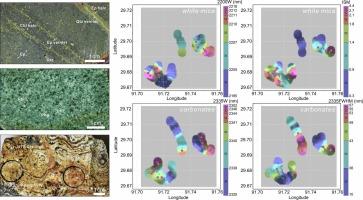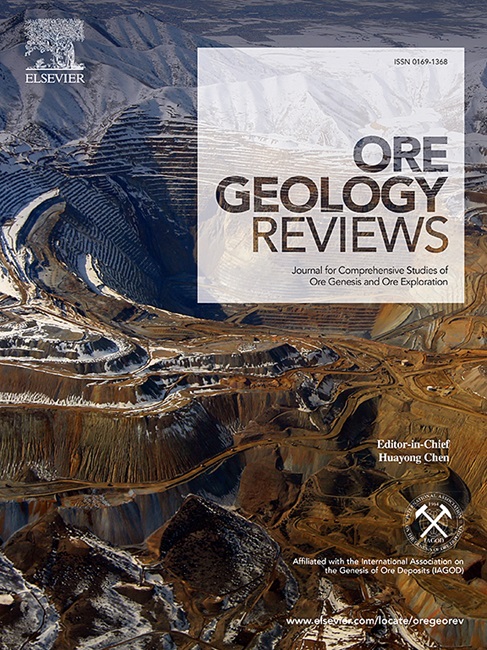短波红外(SWIR)光谱学在绿地勘查中的应用——对甲玛巨型斑岩-斯卡岩系八一-木厂远景区的勘查
IF 3.6
2区 地球科学
Q1 GEOLOGY
引用次数: 0
摘要
甲玛是藏南冈底斯斑岩铜带内的一个巨型斑岩—矽卡岩系统(1814 Mt,含铜0.40%)。最近在矿床西南方向的八一-木厂远景区发现了与甲马相似的铜、钼、钨异常。然而,该外围地区的成矿潜力及其与甲玛的成因联系仍不清楚。利用短波红外光谱技术对八一-木厂远景区蚀变矿物进行了制图,并与甲马矿床西南部的蚀变矿物进行了对比。SWIR结果表明,八一-木厂远景区以绿泥石、云母、石英为主,绿泥石-绢云母蚀变的碳酸盐较少,绿泥石和绿泥石脉晕较少,而普遍存在绿泥石、绿泥石、碳酸盐的丙质组合,表明该区存在独立的热液中心,成矿流体集中溶解,而非甲马矿床的延伸。甲麻矿化带的关键光谱指标包括:白色云母中2200nm波长特征大于2207 nm,伊利石光谱成熟度大于1.4,碳酸盐矿物中2335nm半峰全宽特征大于36 nm。八一-木厂以北多地沟组碳酸盐矿物具有接触变质梯度,2335 nm特征的FWHM自南向北由36 nm增大至56 nm。八一-木厂西北部靠近热液中心,是矽卡岩型和斑岩型成矿的有利靶区。这项研究强调了SWIR光谱测绘在支持斑岩-矽卡岩系统勘探策略方面的有效性,特别是对于绿地目标。本文章由计算机程序翻译,如有差异,请以英文原文为准。

Shortwave infrared (SWIR) spectroscopy for greenfield exploration: Investigating the Bayi-Muchang prospect within the Jiama giant Porphyry-Skarn system
Jiama is a giant porphyry-skarn system (1,814 Mt ore @ 0.40 % Cu) within the Gangdese porphyry copper belt, Southern Tibet. Recently, copper, molybdenum, and tungsten anomalies, similar to those at Jiama, have been identified in the Bayi-Muchang prospect southwest of the deposit. However, the mineralization potential of this peripheral area and its genetic connection to Jiama remain poorly constrained. This study employs shortwave infrared (SWIR) spectroscopy to map alteration minerals in both the Bayi-Muchang prospect and compare them to those in the southwestern Jiama deposit. SWIR spectral results reveal that the Bayi-Muchang prospect is dominated by chlorite, phengite, quartz, and less carbonates from chlorite-sericite alteration with minor epidote and chlorite vein-halos, as well as pervasive propylitic assemblages with chlorite, epidote, and less carbonates, indicating the presence of an independent hydrothermal center where ore-forming fluids were concentrated and exsolved rather than an extension of the Jiama deposit. Key spectral indicators for mineralized zones, derived from Jiama samples, including wavelength of 2200 nm feature longer than 2207 nm and the illite spectral maturity higher than 1.4 in white mica, as well as the full width at half maximum (FWHM) of 2335 nm feature longer than 36 nm in carbonate minerals. Additionally, carbonate minerals in the Duodigou Formation north of Bayi-Muchang record a contact metamorphism gradient, with the FWHM of the 2335 nm feature increasing from 36 to 56 nm from south to north. The northwest Bayi-Muchang area, near the hydrothermal center, is identified as a favorable target for skarn-type and porphyry-type mineralization. This study highlights the effectiveness of SWIR spectroscopy mapping in supporting exploration strategies within porphyry-skarn systems, particularly for greenfield targets.
求助全文
通过发布文献求助,成功后即可免费获取论文全文。
去求助
来源期刊

Ore Geology Reviews
地学-地质学
CiteScore
6.50
自引率
27.30%
发文量
546
审稿时长
22.9 weeks
期刊介绍:
Ore Geology Reviews aims to familiarize all earth scientists with recent advances in a number of interconnected disciplines related to the study of, and search for, ore deposits. The reviews range from brief to longer contributions, but the journal preferentially publishes manuscripts that fill the niche between the commonly shorter journal articles and the comprehensive book coverages, and thus has a special appeal to many authors and readers.
 求助内容:
求助内容: 应助结果提醒方式:
应助结果提醒方式:


